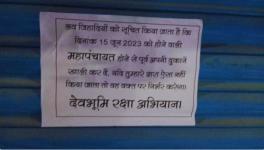‘Post Facto’ Environmental Clearance Set to be New Normal in India

Representational image. | Image Courtesy: Counter View
New Delhi: In what could spell catastrophe for the lives and livelihoods of millions of citizens across the country, the Central government has sought to introduce new rules whereby environmental clearances can be granted to industrial projects on a post facto basis. That is, projects that have commenced operations – by way of construction, installation, excavation, production, etc – without obtaining necessary clearances can be legalised as per provisions of the Draft Environmental Impact Assessment (EIA) Notification, 2020 when it comes into effect.
The notification has been, at present, put up in the public domain by the Union Ministry of Environment, Forests and Climate Change of the Bharatiya Janata Party (BJP)-led National Democratic Alliance (NDA) government, inviting objections and recommendations to it, for which the last date is May 5.
The provision in the notification, which allows granting of post facto environmental clearances, is being seen as a tool that could be used by business interests to easily bypass environmental concerns affecting millions of people in order to maximise their own profits. The provision, once it is in place, will allow industries to circumvent the process of EIA which has so far been mandatorily conducted beforehand in order to ascertain the scale of setbacks that are likely to be suffered by natural settings owing to the construction of a project.
The post facto clearance can be granted against payment of a penalty, which as per further provisions of the notification, will be fixed at 1.5 times of the “ecological damage assessed and economic benefit derived due to the violation” if the application for it is made suo motu by the project proponent.
The penalty will, however, be fixed at two times the extent of damages and benefits if the violation is reported by any government agency. The sole prerogative of determining the extent of the “ecological damage assessed and economic benefit derived due to the violation” will be that of an Appraisal Committee appointed for the purpose.
The committee, however, will be empowered to scrap a project altogether only if it has been constructed at a site where it is not permissible to be set up as per provisions of the law.
The Food and Agriculture Organisation (FAO) of the United Nations defines the purpose of EIA as alerting decision makers, regulatory agencies and the public of environmental consequences of projects “so that those projects can be modified, if need be, to prevent environmental deterioration, to avoid construction errors and to forestall economic losses caused by negative side effects.” A post facto assessment defeats the very purpose of EIA as has been described by the FAO because irreversible ecological damage will already have been committed with the commencement of operations.
“The provision is likely to encourage industries to commence operations without bothering for clearance and eventually get regularised by paying the penalty amount. It is likely to open a floodgate of violations and give rise to a situation of fait accompli, where damage to the environment is irreversible. The provision goes against the precautionary principle which is the sole basis of Environmental Impact Assessments,” said New Delhi-based environmental lawyer Parul Gupta.
The provision also circumvents various judgements of the Supreme Court of India which have held post facto clearances as going against the provisions of the Environment (Protection) Act, 1986 and the Right to Life guaranteed to citizens as a Fundamental Right under Article 21 of the Constitution of India.
However, this is not the only attempt by the NDA government to grant post facto environmental clearances to industrial projects. “Three years ago, in March 2017, the Central government had introduced a one-time amnesty scheme, opened for a period of six months, whereby industries that had not procured prior environmental clearances were invited to fill in applications to procure them on a post facto basis. It is worrisome for environmental conservationists to see that this amnesty scheme is now being attempted to be made a permanent feature in environmental laws in the country,” said independent environmental researcher, Meenakshi Kapoor.
The amnesty scheme for post facto environmental clearances had been introduced in March 2017 after the National Green Tribunal quashed procedures laid in place by the erstwhile Congress-led United Progressive Alliance (UPA) government to grant post facto environmental clearances to violators. The Union Ministry of Environment & Forests (as it was called under the Congress-led United Progressive Alliance regime) had issued the two memoranda in quick succession – in December 2012 and June 2013. The green court quashed these memoranda, in an order issued by it in July 2015, on the grounds that they cannot subvert a central government notification.
The NDA government thereafter brought out the amnesty scheme justifying it with the argument that existing operational units are more polluting if they are not brought under the environment compliance regime. Apparently, the idea behind the scheme, as per the own words of the central government, was “to take away the economic benefit (if any) derived by the company due to violation and pay for the remediation of damage caused due to violation” as per the own words of the government. Only the central government, however, was empowered to examine all cases of violations under this amnesty scheme.
The central government had promulgated an EIA notification for the first time, under the provisions of the Environment (Protection) Act, 1986, in the year 1994. A new notification was again brought out in the year 2006 which empowered state governments too with the responsibility of clearing certain projects depending on the size and capacity. Environmental clearances were made mandatory, not only for new projects but also for “expansion or modernisation” of existing projects.
The draft notification of 2020 attempts to blur the difference between expansion and modernisation.
In January 2020 the central government had amended the EIA rules of 2006 – without public consultations or hearings – whereby the need for a prior environmental clearance was ruled out for changing the raw material or product mix of a project where it wanted to increase its production capacity by as much as 50 per cent. In the new draft notification, the central government has gone further to include changes in raw material or product mix under the definition of ‘modernisation’ itself in contrast to the notification of 2006 which made a clear differentiation between ‘modernisation’ and ‘change in product mix’.
Besides, the draft notification has also done away with the need to apply for a new environmental clearance for existing projects when it intends to go for an increase in its production capacity by as much as 25%. The need for public consultations is intended to be totally done away with for projects that go for increase in production capacity by as much as 50%.
In fact, the draft notification, in more ways than one, tries to minimise public participation in determining impacts of any particular industrial project on livelihoods and environment. The new notification seeks to reduce the minimum period offered to the public to notify their responses to the Environment Impact Assessment report of any project from the existing 30 days to 20 days.
As per experts, provisions in the notification are lenient on mining leaseholders too as far as environment protection norms are concerned. In accordance with Section 19 (1) (I) (d) of the notification, the period of validity of a prior environmental clearance of a mining project, for the purposes of construction and installation of machinery, can stretch over the entire life of the project provided mining activities commence within 10 years from the date of grant of the clearance.
“A mining leaseholder can begin construction and installation of machinery as much as ten years after obtaining an environmental clearance. The environmental conditions under which the clearance would have been granted must have changed by the time mining activities commence after a decade. In any case, the new notification is being pushed during the period of the Covid 19 pandemic. There is no tearing hurry for the government to push through the legislation when the entire country is under lockdown,” said R Ravi, Chairperson of mines, minerals and PEOPLE, an alliance of individuals and communities concerned and affected by mining.
The writer is an independent journalist. The views are personal.
Get the latest reports & analysis with people's perspective on Protests, movements & deep analytical videos, discussions of the current affairs in your Telegram app. Subscribe to NewsClick's Telegram channel & get Real-Time updates on stories, as they get published on our website.
























